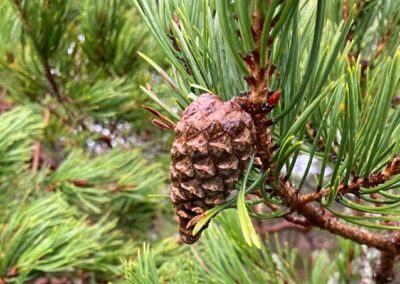Transforming ash genomics: Creating a pangenome to understand ash dieback resistance
Project lead(s) Dr Laura Kelly | Research Leader, RBG Kew; Dr Daniel Wood | Research Fellow, RBG Kew, Dr Mohammad Vatanparast | PDRA, RBG Kew
Project status Complete (April 2022 – March 2025)
Context
The European ash tree (Fraxinus excelsior) is one of the most common woodland trees in the UK, but over the last decade has suffered severe damage from an invasive fungus (Hymenoscyphus fraxineus) that causes ash dieback disease.
Previous research has shown that a small percentage of ash trees have resistance to the disease resistance which can be passed to offspring and we have some understanding of the genomic basis (differences between individuals across the whole genome) for this. However, a more complete understanding of the basis of resistance is required to be able to accurately predict the health of individual trees.
Most studies of genomic variation look at single points on the genome that differ between individuals. This project will explore genomic structural variation, which may be important for resistance to ash dieback, but which is difficult to assess. Genomic structural variation is where entire regions of DNA are inverted, duplicated, deleted or moved elsewhere in the genome in some individuals.
An improved understanding of the genomic basis of ash dieback resistance will allow selection of more resilient trees for breeding programmes and woodland restoration.
Research Aims and Objectives
This project aims to transform our understanding of the genomic basis of ash dieback resistance by using the latest developments in genome sequencing and analysis to discover structural variants and construct a pan-genome – a reference genome incorporating information from diverse individuals rather than based on a single individual, as is the case with traditional approaches.
Our research objectives are to:
- Construct a high-quality ash pan-genome capturing common structural variants
- Use this new resource to identify structural variants associated with ash dieback resistance
- Improve prediction of ash dieback resistance of individual trees by incorporating structural variant data
Project Description
We will use long-read sequencing data (DNA that is sequenced in sections that average thousands of base pairs in length, rather than the more commonly used short-read) to construct a pan-genome and identify structural variants across the genome. The pan-genome will be used to find structural variants in individuals from both planted trials and a natural woodland and to identify variants associated with ash dieback resistance.
Tissue collection and genome sequencing: Samples will be collected from resistant and susceptible individuals from screening trials and mature trees in natural woodland.
Pan-genome construction: Long-read sequence data will be mapped to an improved reference genome to identify variants and construct an annotated pan-genome graph that shows the locations of genes and structural variants.
Identification of structural variants associated with ash dieback resistance: We will map sequenced DNA from the samples to the new pan-genome to find individual differences. Structural variants significantly associated with ash dieback resistance will be identified and we will establish whether accounting for structural variants results in more accurate genomic prediction of individual ash dieback resistance.
Outputs
Our outputs will be:
- A high-quality pan-genome for European ash
- A collection of structural variants associated with ash dieback resistance
- A genomic prediction model for ash dieback resistance incorporating structural variants
- Publications describing these results

Evidence of ash dieback infection
Share this project on social media
Related Projects
Our Partners
Social media
Explore
Contact
© 2022 Centre for Forest Protection. All rights reserved.


